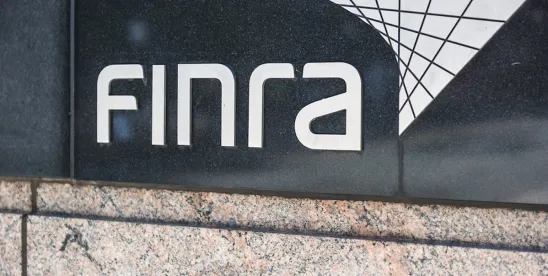Welcome to the latest issue of Bracewell’s FINRA Facts and Trends, a monthly newsletter devoted to condensing and digesting recent FINRA developments in the areas of enforcement, regulation and dispute resolution. We dedicate this month’s issue to FINRA’s 2025 Annual Regulatory Oversight Report. Read about the Report’s findings and observations, below.
FINRA Issues 2025 Regulatory Oversight Report
On January 28, 2025, FINRA published its 80-page 2025 Regulatory Oversight Report (the Report), offering insights and observations on key regulatory topics and emerging risks that firms should consider when evaluating their compliance programs and procedures. Broadly speaking, the Report identifies relevant rules, summarizes noteworthy findings, highlights key considerations for member firms’ compliance programs, and provides helpful and practical considerations as member firms analyze their existing procedures and controls.
The 2025 Report discusses 24 topics relevant to the securities industry. While many of these are perennially important topics, the Report also includes two new sections: third-party risk landscape and extended hours trading. Below, we provide an overview of the Report’s new priorities, together with certain continuing priorities highlighted in the Report.
A FINRA Unscripted podcast episode about the report — featuring Executive Vice President and Head of Member Supervision, Greg Ruppert, Executive Vice President and Head of Market Regulation and Transparency Services, Stephanie Dumont, and Executive Vice President and Head of Enforcement, Bill St. Louis — is available on FINRA’s website.
Newly Identified Priorities
- Third-Party Risk Landscape: The most significant addition to the Report is a new top-level section on Third-Party Risk Landscape. Firms’ reliance on third parties for many of their day-to-day functions create risks, and, as the Report indicates, this new section was prompted by “an increase in cyberattacks and outages at third-party vendors” firms use.
As the broad heading indicates, the newly added material outlines effective practices and general steps to be taken by firms, including:
- maintaining a list of all third-party vendor-provided services, systems and software components that the firm can leverage to assess the impact on the firm in the event of a cybersecurity incident or technology outage at a third-party vendor;
- adopting supervisory controls and establishing contingency plans in the event of a third-party vendor failure;
- affirmatively inquiring if potential third-party vendors incorporate generative AI into their products or services, and evaluating and reviewing contracts with these third parties to ensure they comply with the firms’ regulatory obligations, i.e., adding contractual language that prohibits firm or customer information from being ingested into the vendor’s open-source generative AI tool;
- assessing third-party vendors’ ability to protect sensitive firm and customer non-public information and data;
- ensuring that a vendor’s access to a firm’s systems and data is revoked when the relationship ends; and
- periodically reviewing the third party’s vendor tool default features and settings.
- Extended Hours Trading: In recent years, trading in National Market System stocks and other securities has extended beyond regular trading hours. In its other new section, FINRA reminds firms that offer extended hours trading that they must comply with FINRA Rule 2265, which requires that these firms provide their customers with a risk disclosure statement. Importantly, if a firm allows its customers to participate in extended hours trading online, the firm must be sure to post a risk disclosure statement on the firm’s website “in a clear and conspicuous manner.” In addition to Rule 2265, firms participating in extended hours trading must also comply with FINRA Rule 5310 (Best Execution and Interpositioning) and Rule 3110 (Supervision).
The Report recommends the following best practices to address any perceived risks associated with extended hours trading:
- conducting best execution reviews geared toward evaluating how extended hours orders are handled, routed and executed;
- reviewing customer disclosures to ensure they address the risks associated with extended hours trading;
- establishing and maintaining supervisory processes designed to address the “unique characteristics or risks” of extended hours trading; and
- evaluating the operational readiness and customer support needs during extended hours trading.
Continuing Priorities
In addition to the Report’s new topics, each of the Report’s sections — Financial Crimes Prevention, Firm Operations, Member Firms’ Nexus to Crypto, Communications and Sales, Market Integrity, and Financial Management — places special emphasis on certain continuing priorities that will remain key focus areas for FINRA in 2025:
- Reg BI and Form CRS: Reg BI and Form CRS have been perennial areas of focus for FINRA since they first became effective in 2020. The 2025 Report details a number of new findings and observations for each of the four component obligations of Reg BI (Care, Conflict of Interest, Disclosure, and Compliance).
With respect to the Care Obligation, many of FINRA’s latest findings and observations center around firms’ obligations with respect to recommendations of complex or risky products. FINRA reminds firms making such recommendations to consider whether the investments align with the customer’s overall investment profile, and whether the investment would result in concentrations that exceed the firm’s policies or the customer’s risk tolerance, or that represent an inappropriate portion of a retail customer’s liquid net worth.
The primary addition to the Report concerning firms’ Conflict of Interest Obligation is a finding that firms may violate Reg BI by failing to identify all material conflicts of interest that may incentivize an associated person to make a particular recommendation, such as a financial incentive to recommend the opening of an account with the firm’s affiliate, or to invest in securities tied to a company in which the associated person has a personal ownership stake.
The Report also contains a new finding related to the Compliance Obligation, noting that firms must have written policies and procedures that address account recommendations (as distinct from investment recommendations), including transfers of products between brokerage and advisory accounts, rollover recommendations, and potentially fraudulent patterns of account switches by the same associate person.
While the Report contains no new findings or observations related to the Disclosure Obligation, FINRA continues to remind firms of their obligation to provide customers “full and fair” disclosures of all material facts related to the scope of their relationship and any conflicts of interest.
As it relates to Form CRS, the Report’s findings included failures to properly deliver Form CRS and to properly post Form CRS — including posting Form CRS on any websites maintained by financial professionals who offer the firm’s services through a separate “doing business as” website.
- Cybersecurity and Cyber-Enabled Fraud: The Report’s section on Cybersecurity and Cyber-Enabled Fraud — titled Cybersecurity and Technology Management in previous years’ reports — includes several important additions in 2025.
Most prominently, the Report highlights the emerging risks associated with quantum computing, a new technology that relies on quantum mechanics to perform functions not possible for more traditional forms of technology. Noting that many financial institutions have recently begun exploring use of quantum computing in their business operations, the Report warns that these technologies could be exploited by threat actors. Among other things, quantum computing has the potential to quickly break current encryption methods utilized by firms in the financial services industry. FINRA recommends that firms considering the use of quantum computers place a particular emphasis on ensuring cybersecurity, third-party vendor management, data governance and supervision.
The Report also discusses a variety of cybersecurity threats and attacks that financial institutions must be prepared to counter. First, the Report observes an increase in the variety, frequency and sophistication of many common threats, including new account fraud, account takeovers, data breaches, imposter sites, and “quishing” (an attack that uses QR codes to redirect victims to phishing URLs). In addition to these more conventional threats, the Report also describes several emerging threats, including: Quasi-Advanced Persistent Threats (Quasi-APTs) (sophisticated cyberattacks intended to gain prolonged network or system access); Generative AI-Enabled Fraud (attacks that make use of emerging generative AI technology to enhance cyber-related crimes); and Cybercrime-as-a-Service (attacks perpetrated by criminals with technical expertise on a for-hire basis, or by selling cyber-attack tools to third parties).
Among the effective practices recommended by FINRA to combat these threats, the Report highlights two new practices: tabletop exercises, in which firms bring internal and external stakeholders together to ensure cyber threats are appropriately identified, mitigated and managed; and lateral movement, a method of subdividing a firm’s networks into various sections to make it more difficult for threat actors to gain access to a network in its entirety.
- Senior Investors and Trusted Contact Persons: FINRA remains keenly focused on preventing the financial exploitation of senior investors. The Report reminds members of their regulatory obligations under FINRA Rule 4512 with respect to “Trusted Contact Persons” (TCPs) and FINRA Rule 2165 (Financial Exploitation of Specified Adults).
FINRA Rule 4512(a)(1)(F) requires FINRA members to make reasonable efforts to obtain the name of and contact information for a TCP for non-institutional customer accounts to address possible financial exploitation, to confirm the specifics of the customer’s current contact information, health status, or the identity of any legal guardian, executor, trustee, or holder of a power of attorney; or take other steps permitted by Rule 2165. In particular, Rule 2165 permits firms to place temporary holds on securities transactions and account disbursements if the member reasonably believes that financial exploitation of a Specified Adult has occurred, is occurring, has been attempted, or will be attempted. “Specified Adult” means (A) a natural person age 65 and older; or (B) a natural person age 18 and older who the member reasonably believes has a mental or physical impairment that renders the individual unable to protect his or her own interests.
In the “Findings and Effective Practices” section of the Report, FINRA notes that recent examinations and investigation focus on firms not making reasonable attempts to obtain the name and contact information of a TCP; not providing written disclosures explaining when a firm may contact a TCP; not developing training policies reasonably designed to ensure compliance with the requirement of Rule 2165; and not retaining records that document the firm’s internal review underlying any decision to place a temporary hold on a transaction.
As for suggested effective practices, the Report recommends, among other things: implementing a process to track whether customer accounts have designated TCPs, establishing specialized groups to handle situations involving elder abuse or diminished capacity, and hosting conferences or participating in industry groups focused on the protection of senior customers.
- Anti-Money Laundering (AML) and Fraud: FINRA Rule 3310 requires that each member firm develop and implement a written AML program that is approved in writing by senior management and is reasonably designed to achieve and monitor the firm’s compliance with the Bank Secrecy Act and its implementing regulations.
As for recommended effective practices, the Report recommends:
- conducting thorough inquiries when customers — particularly the elderly — request an unusually significant amount of funds to be disbursed to a personal bank account;
- conducting formal, written AML risk assessments;
- incorporating additional methods for verifying customer identities when establishing online accounts;
- delegating AML duties to specific business units that are best positioned to monitor and identify suspicious activity; and
- establishing an AML training program for personnel that is tailored to the individuals’ roles and responsibilities.
The Report highlights one emerging risk: FINRA has observed an increase in investment fraud committed by those that engage directly with investors. This can include persuading victims to withdraw funds from their accounts as part of a fraudulent scheme. The FBI’s Internet Crime Report notes that “investment fraud is the costliest type of crime tracked by the FBI’s Internet Crime Complaint Center.” To help mitigate this threat, FINRA recommends: monitoring for sudden changes in a customer’s behavior, including withdrawal requests that are out of character for the customer; educating firm personnel that are in contact with customers on how to recognize red flags; and developing clear response plans for when the firm identifies a customer that has been victimized.
- Private Placements: The Report’s section on private placements does not stray far from previous years’ reports, and primarily re-emphasizes a key area of focus for FINRA’s Enforcement division over the past two years, first highlighted in Regulatory Notice 23-08. As we reported at the time, Regulatory Notice 23-08 reminded member firms of their obligation to conduct a reasonable investigation of private placement investments prior to making any recommendation — including, most particularly, conducting an investigation of the issuer, its management and its business prospects, the assets held or to be acquired by the issuer, and the issuer’s intended use of proceeds from the offering. In its discussion of findings from targeted exams, FINRA further notes that firms fail to satisfy this obligation when, among other things, they do not conduct adequate research into issuers that have a lack of operating history, or where they rely solely on the firm’s past experience with an issuer based on previous offerings. FINRA’s findings offer a reminder to firms to apply scrutiny to all offerings, whether or not the issuer is a known quantity — and to be especially vigilant when an issuer is new to the space.
The Report’s findings also provide another cautionary tale: FINRA warns that firms fail to comply with Reg BI’s care obligation when they take the position that the firm is not making recommendations, even though the firms’ representatives have made communications to customers that include a “call to action” and are individually tailored to the customer. Firms should remain aware that these types of communications are likely to be viewed as investment recommendations, and ensure that they conduct reasonable diligence before making any such communication to a customer.
The Report also discusses an emerging trend concerning firms that have made material misrepresentations and omissions related to recommendations of private placement offerings of pre-IPO securities. As examples, FINRA cites firms that have failed to disclose potential selling compensation, and that have failed to conduct reasonable due diligence to confirm that the issuer actually held or had access to the shares it purported to sell.
- Manipulative Trading: Member firms are prohibited, pursuant to a series of FINRA Rules, from engaging in impermissible trading practices. The relevant rules include FINRA Rule 2010 (Standards of Commercial Honor and Principles of Trade); FINRA Rule 5230 (Payments Involving Publications that Influence the Market Price of a Security); and FINRA Rule 5210 (Publication of Transactions and Quotations), which FINRA has relied on in pursuing enforcement actions accusing member firms of publicizing or circulating inflated trading activity.
The Report highlights certain recent findings, including firms having inadequate WSPs, not establishing surveillance controls designed to capture manipulative trading, and not establishing and maintaining a surveillance system reasonably designed to monitor for potentially manipulative trading.
- Communications With the Public: As in previous years, the Report details the content standards prescribed for three categories of firm written communications: correspondence, retail communications and institutional communications.
The Report also presents findings on an emerging trend: retail communications focused on registered index-linked annuities (RILAs). FINRA’s findings concerning firms’ communications related to RILAs mirror many of the common findings in connection with other types of investments. For example, FINRA has found that firms have failed to adequately explain how RILAs function and the meaning of specialized terms that are specific to RILAs, as well as finding that firms have made inadequate disclosures of the risks, fees and charges associated with RILAs.
The Report also contains a new focus on firms’ communications made through social media and generative AI. In particular, it recommends that firms ensure that communications made with the assistance of generative AI (including chatbot communications used with investors) are appropriately supervised and retained. Similarly, the Report cautions that firms must maintain systems, including WSPs, reasonably designed to supervise communications disseminated on the firm’s behalf by influencers on social media.
The Report’s findings and observations are intended to serve as a guide for member firms to assess their current compliance, supervisory, and risk management programs and note any perceived deficiencies that could result in scrutiny by FINRA. Member firms are encouraged to focus on the findings, observations and effective practices relevant to their respective business models.




 />i
/>i

